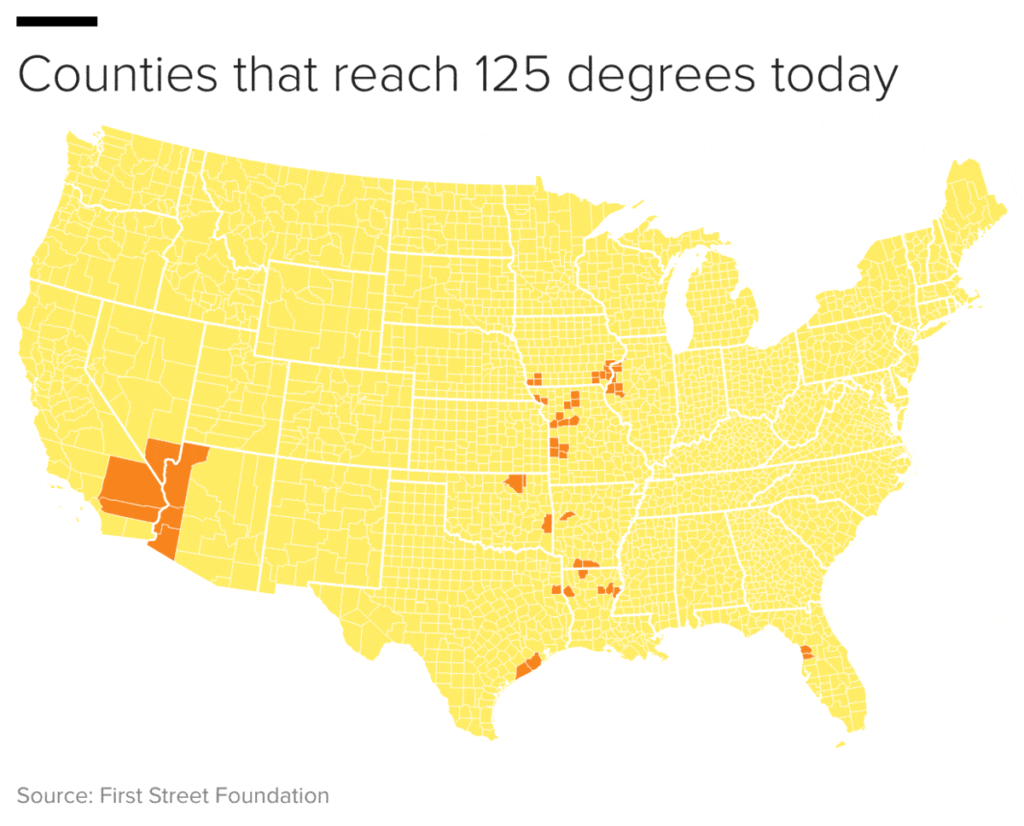‘Extreme Heat Belt’ Will Affect Much of the U.S. by 2050, Study Finds

 Why you can trust us
Why you can trust us
Founded in 2005 as an Ohio-based environmental newspaper, EcoWatch is a digital platform dedicated to publishing quality, science-based content on environmental issues, causes, and solutions.
If you thought this summer’s extreme temperatures were dangerous and stifling, get ready for more, as the hottest days of the year are going to occur more often and be more intense in much of the U.S.
A new study by climate research nonprofit First Street Foundation predicts that climate change will bring more days with temperatures climbing into the National Weather Service’s “extreme danger” category — when the heat index reaches higher than 125 degrees Fahrenheit, reported CNN.
This year, about eight million people are predicted to be affected by days with “extreme danger” temperatures. By 2053, 107 million people — 13 times as many — are expected to be subjected to that level of extreme heat, according to First Street Foundation.
“The United States faces a challenging problem of adapting to extreme heat that is getting worse over time,” the study said. “Changing environmental conditions are driving increasing heat risks by influencing average temperatures and humidity across the country. Conservative estimates show temperatures across the United States increasing by a minimum of 2.5°F over the next 30 years.”
According to the study, temperatures will rise more in some areas, especially in the “Extreme Heat Belt.”

“The top 5 metropolitan areas by the number of impacted neighborhoods expected to experience these Extreme Danger Days are St. Louis, MO; Kansas City, MO; Memphis, TN; Tulsa, OK; and Chicago, IL,” projected the study. “These states are part of this Extreme Heat Belt, made up of areas relatively distant from the ocean which generally do not benefit from the coastal breezes that help to keep the Southwest, Southeast, and East Coast from hitting these extreme temperatures currently. However, in 30 years, coastal areas along the Gulf and Eastern seaboard are also expected to experience more Extreme Danger Days.”
During the hottest part of the year, temperatures in the Extreme Heat Belt will reach higher than 125 degrees Fahrenheit for more than 100 million people, CNN reported.
Some states in the southern part of the country, like Florida and Texas, could experience 100-degree temperatures for more than 70 days straight, reported The Washington Post.
“We’re talking about taking summer, which is already hot, and expanding it for months,” said Director of the Houston Healthy Cities program for the Nature Conservancy in Texas Jaime González, as The Washington Post reported. “That’s going to cause all sorts of disruptions to everyday life.”
Miami-Dade County in Florida will experience the biggest extreme temperature change, with next year’s hottest week of the year — consisting of days with temperatures in excess of 103 degrees Fahrenheit — stretching into more than a month, reported CNN.
Due to systemic unfairness, the likelihood of illnesses and death associated with heat disproportionately affects communities of color, ABC News reported.
According to a Wilderness & Environmental Medicine journal report, from 2005 to 2015, heat-related trips to the emergency room rose by 67 percent for African Americans, 63 percent for Hispanics, 53 percent for Asian Americans and 27 percent for white people.
The Centers for Disease Control and Prevention reported that from 2004 to 2018, the rates of heat-related death were highest for Indigenous groups, followed by African Americans.
In the next three decades, local heat waves have the greatest chance of occurring on the West Coast, the study predicted.
“Interestingly, exposure to Consecutive Local Hot Days is most likely to occur in West Coast states, while states in the Midwest, Southeast, and East Coast are most at risk of exposure to extremely dangerous temperatures, meaning virtually the entire country is subject to increasing perils associated with heat exposure,” the study said.
As people rely more on air-conditioning to deal with the new normal of hotter temperatures, energy grids could become strained, potentially leading to a higher frequency of rolling blackouts and brownouts, according to the study.
“The increase in extreme heat conditions are a cause for concern, impacting everything from personal health to electricity costs associated with increased air conditioning usage, to physical infrastructure, and even public transport,” the study said.
Subscribe to get exclusive updates in our daily newsletter!
By signing up, you agree to the Terms of Use and Privacy Policy & to receive electronic communications from EcoWatch Media Group, which may include marketing promotions, advertisements and sponsored content.

 233k
233k  41k
41k  Subscribe
Subscribe 




